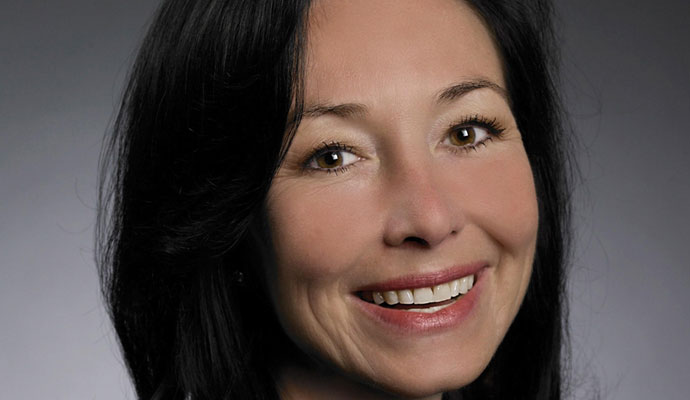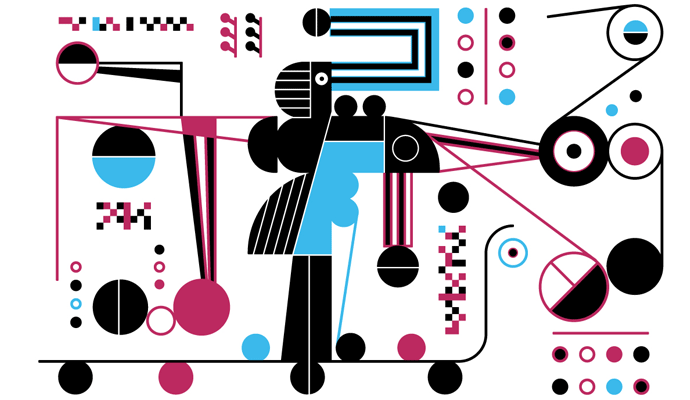At Oracle, Great Technology Is Not Enough
In the first interview in this series, which kicks off PwC’s 2018 CEO Survey, chief executive Safra Catz explains the broad culture shift brought on by AI and cloud technologies.
This interview is part of the Inside the Mind of the CxO series, which explores a wide range of critical decisions faced by chief executives around the world.
Since its founding in 1980, the Oracle company has been known for its prowess at innovation, for its protean array of enterprise software and database products, and for its influential leadership, starting with the three individuals at the top of the company. Founder and board chairman Larry Ellison and CEO Mark Hurd are among the most visible figures in the technology industry. In their company, it would be easy to be overlooked — but not if you’re Safra Catz.
In recent years, Catz — also Oracle's CEO, as well as CFO and a member of the board of directors — has been one of Silicon Valley’s most prominent voices on the maturation of digital technology and its effect on global industry. This in part reflects her standing as one of the most highly placed women in business, and her experience executing Ellison’s vision for Oracle’s transformation into a cloud- and platform-oriented company. She is also credited with shifting the company’s growth strategy in 2003 from one that rarely involved mergers and acquisitions to one that has used inorganic growth to great advantage.
Catz was born in Israel and raised, after age 6, in the Boston area. Before coming to Oracle in 1999, she was an investment banker at Donaldson, Lufkin & Jenrette. In 2011, she was named co-president of Oracle, and took the CEO position in 2014. She served on the board of directors for HSBC Holdings from 2008 through 2015, and will join the Disney board in 2018. Strategy+business visited her in early December 2017, at Oracle’s headquarters in Redwood City, Calif., to discuss the challenges facing CEOs today and their changing strategic priorities.
S+B: The world seems to be crossing a threshold of digital maturation, with artificial intelligence, blockchain, sensors, and the Internet of Things all coming together. What’s the most significant aspect of this shift?
CATZ: Everything is important, but I think the most critical is the fact that AI is finally here. What is AI? It’s making decisions based on very large amounts of data. I’ve been hearing about AI for 30 years...but it was always a future promise. What's different now? First, the underlying compute capability is so much faster, meaning systems can crunch through a deluge of data almost instantaneously. Two, the ability, through software, to manage and analyze that data is so much better.
Do you remember the days when position-sensing elevator technology came at an exorbitant price? It cost millions to put that in your building. Now, your smartphone can tell what floor you’re on. It’s measuring barometric pressure. It’s measuring if you’re standing or sitting down. Your Waze app measures not only how fast your car is traveling, and where the other cars are around you, but your acceleration and deceleration. Your watch knows your heartrate. All this technology used to be incredibly expensive. Now, you get advanced computing capability at commodity prices.
The world has seen explosions of data in the past, and each time, enterprises have tried to manage it in one way or another. But this time, it’s accompanied by much faster and more accessible computing capability. All this data is instantly rendered usable and actionable, and that creates an unprecedented opening for artificial intelligence. Of course, we have heard about AI for decades in the software industry. It was always a promise of the future. The programs were based on running rules with inputs that included far less data, and less processing power. But now, the underlying computing capability is much faster, meaning it can crunch through huge amounts of data. And the software technology is far more advanced than it was. The systems can not only augment decisions, but can make them better and faster — freeing up employees and consumers to do more interesting things. As your car drives you to work, you can be reading your briefing for your first meeting, and your car may very well be a better driver than you are. In computing, the system will see anomalies, detect security threats, and fix the problems faster than an individual could.
S+B: How does that affect the day-to-day business of a typical company?
CATZ: The main task of AI is to improve decisions. If executives have a clearer view of the patterns in the data, they can make better decisions themselves, or delegate decisions with confidence that they would otherwise have to make themselves. This represents a natural evolution for the software industry. Increased computer power leads to an ability to manage huge amounts of data simultaneously, and bring it all together. It also means increased speed: Historically, if you had to wait a long time for an answer, it was not worth asking the question. Now you get your answer quickly. And finally, scalability: If you can’t handle huge amounts of data across large distances, you can’t get a complete answer. All of this adds up to a step change in information.
S+B: Why is that important?
CATZ: Because all those effects — speed, scale, security — release resources and people to do much higher-value things. And that’s what’s happening now. We’re starting to see enormous productivity increases. I’m not sure how economists measure productivity in this country, but no one can deny that our capabilities have increased enormously.
S+B: Speak to this from your background as a finance executive. What kinds of things can companies do now that they couldn’t do before?
CATZ: Historically, finance sat in the back seat, looking in the rearview mirror. “Where have we been? How much money did we make? What changed from last quarter?” The job of finance was to answer questions like those.
“The effects of AI — speed, scale, security — release resources and people to do much higher-value things. We’re starting to see enormous productivity increases.”
With modern systems, looking backward is much easier, but so is looking forward. The systems calculate what happened in a very accurate way. Finance now rides shotgun; it is the navigator of the car. Yes, the line of business is driving, but finance is looking forward, suggesting routes to try out, and modeling new possibilities. You don’t just extrapolate from the past; you are free to see what else is going on. This is a totally different job, partnered up with the lines of business.
Are all finance people up to the task? Maybe not. And we still have to get the backward-looking numbers correct. But these days, I rarely see the line-of-business leaders without their finance people, and it builds a kind of collaboration that advances the business, in ways that weren’t possible before.
This role for finance goes beyond asking “what if” questions. Analytics are built in. You know at any minute what your contracts are worth, where your sales are going. This allows you to layer in additional possibilities. What are your competitors doing? What happens with pricing differences?
Computers could do these kinds of analyses before, but slowly, and at enormous cost. Now, you can make better decisions and make them much sooner. You don’t have to wait and see how everything turns out; you now have a good idea about how the decision will turn out before you make it.
S+B: Do you see businesses doing anything differently as a result?
CATZ: Listen. Change is hard, but many businesses are just starting to embrace it.
Interestingly, the finance people are often leading the charge of change. You might think that they would be saying, “Whoa, I know my existing job, I prefer it the way it was.” But when I speak publicly about this, it’s the finance people in the audience who are saying, “When can we get started?” They want to help their companies. They can’t wait to get into this. All of a sudden, they realize that there are modern tools they can use to really help the business.
That’s why many new software products have analytics built in, and why they’ve moved into the cloud. In the legacy world, companies were locked into their on-premises systems. It took them six months to two years to upgrade to the coolest technology. In the cloud, it just shows up. All of a sudden, you have a new feature you didn’t have before. It doesn’t require a long implementation.
Overcoming Internal Inertia
S+B: How does this change the way companies grow?
CATZ: It changes the speed at which they make decisions. They understand their customers better. They can tailor their value proposition on the fly. Or they see there’s a market they would otherwise have missed for their products, and they need to hire more people.
As far as I know, nobody in business can just rest on their laurels right now. Competition is brutal. Who would have anticipated what’s happening in retail, in telecommunications, in media? Name one industry where people are saying, “I’m going to pass on this change. I don’t have to worry about competition. I’m going to go slow. I like slow.” They all want to go faster. They know that CEOs are turning over, being let go. Investors have no patience at all.
The companies have to make some hard choices; they’ve got to show some courage. People want to love change, but they hate change. It’s terrifying.
In any employee base, there’s a small group in the front who say, “I’m in. This change is going to be awesome.” There’s a small group in the back who think they’ll never accept it; it will happen over their cold, dead body. And there is a gigantic group in the middle who will go with whichever side is winning. They want answers to their questions: “What’s in it for me? Why is this good for my group? Why is this good for the company?”
You answer them by saying, “Look. You can have a report today that you used to wait three weeks for. Or try these alternative approaches.” You support their capabilities and give them information — data they can act on. If you start building momentum, the giant group in the middle goes from, “Hmm, let’s see how this works out,” to, “Hey, what about me? I’m in.” And even some of the over-my-dead-body group goes, “You know what? I’m not so afraid anymore.”
S+B: This could be said about any change, not just a technological one.
CATZ: I wish I could say that your success in change depends only on technology. It doesn’t. It also depends on sociology, on the people. Sure, if your technology isn’t good, that could be fatal. But great technology is not enough. There has to be leadership, supporting the changes and saying, “We’re doing this.” There’s going to be a lot of inertia — people wanting to do it the old way.
S+B: You’re credited as having led this type of transformation yourself.
CATZ: I can honestly tell you that is untrue. Larry Ellison led the transformation to the cloud, and before that our transformation to the Internet. It was in 1999. Imagine the courage it took. We were at the height of the software bubble. Everything was fabulous. There was no emergency driving us to change.
But he said we had to shift to a single global enterprise. We had to bring all the data together from around the world, so we could run our company better and spend less doing it.
We thought we were global, but we were only international. Being international means selling in a lot of countries. Being global means having the same high standard everywhere. Customers know what to expect. It means simplifying your system, and your business. And in our case, we saved [US]$1.2 billion.
S+B: How does a company accomplish that kind of thing?
CATZ: There are two main factors. First, when you do things more simply, you have far less duplication of effort. Second, you need to put your target out publicly. For example, shortly after I joined Oracle in May 1999, Larry said, “We’re going to save a billion dollars by switching our systems.” We had only $9 billion in revenue at the time.
When a CEO makes an announcement like that, executives either embrace the change or they start hearing rumors about their replacements. You can no longer duplicate one another’s efforts when you cut that much. You can’t waste money on projects that don’t make you more competitive.
We still see companies spending an absolute fortune on financial systems and HR systems that don’t do much for their business. What customer of theirs says, “Oh yeah. I love your IT installation. It’s fantastic”? How does it make you a better retailer, a better manufacturer, a better bank? It doesn’t.
Reasons for Economic Optimism
S+B: There seems to be a high level of confidence in economic growth, especially in the United States, these days. What do you attribute this to?
CATZ: The optimism in the United States is very, very high. The response to reduction in regulations, which eat up an enormous amount of business investment in paperwork and compliance, is immediate. That downward trajectory [in regulations] is allowing investment in other areas. Even though the tax bill hadn’t yet been signed when your survey was conducted, there was a clear path in view. It would reduce regulation, reduce taxes, and free up capital.
In my opinion, the most important type of tax cut is the one that goes to the middle class, because we live in a consumer-based economy. And when consumers have more money, they spend it. That’s good for every type of company. The consumer spends more at Target, Target buys another forklift, and the forklift maker buys a newer IT system. This type of cycle is making leaders more optimistic.
S+B: At the same time, we know many executives who feel uncertain about their own company’s prospects.
CATZ: That’s because they’re watching digital disruption unfold. In financial services, new fintech companies are competing. They aren’t banks; they’re technology companies. But the transactions are migrating to them, and it’s making the banks wonder what just happened. Media companies are shifting just as fast. Once, if you made a movie or TV show, you’d call the distributors. Now you put it on the Internet and people watch it through their smartphone. That library of old movies you had carefully assembled, as a media company, may need to be monetized a different way. We’re not ready for this. You can’t be calm when everything around you is changing.
Customers Demand Collaboration
S+B: With the emergence of cloud-based industrial platforms, how do you see the industry evolving?
CATZ: Historically, Microsoft and Oracle were archenemies. We still compete. We also compete fiercely with Amazon. But both Microsoft and Amazon are Oracle customers. Why do we work together? Because our customers demand it.
Our underlying philosophy is that every customer will have multiple clouds. It’s their choice, and it brings us back to our initial history. In our earliest days, we were competing with so many databases: DB2, RDB, Adabase, etc. What was so unique about us? We didn’t decide what hardware platform you used. An Oracle database would run on any computer: Digital Equipment, IBM, Data General, Wang, Prime, and even on the new personal computers of that time. (I’m dating myself a little.) We said, “Go run on whatever you want. It’s the customer’s call.”
Today, we have our own cloud system, but we don’t require you to use it. You can bring your Oracle licenses to someone else’s cloud. But we work very hard to make sure that we will run Oracle better, faster, more securely, and cheaper than anyone else.
Ultimately, I believe that most of our customers will have a minimum of three or four clouds for their different needs. One of them will be Oracle.
S+B: So you all have to compete on quality instead of locking people into a single system with high switching costs.
CATZ: This is the most exciting time because there is a lot of change and opportunity. All the CEOs I know are working very hard. Even the most successful among them, like Larry Ellison, come to work every day for that reason. The opportunity is great, but there is no resting on your laurels.




